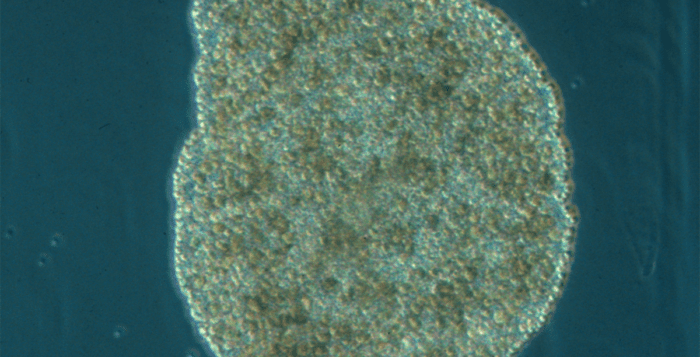By Elof Axel Carlson

Biologists classify living things using a system that Carl Linnaeus (1707–1778) introduced in the 18th century and that has grown in detail over the decades as new forms of life are found and studied. Humans are familiar with being vertebrates (a class of the phylum Chordata). Chordates are animals with a spinal cord, spine or an embryonic structure called a notochord. There are 55,000 chordate species. So far there are 109 phyla covering plants, animals, protozoa, fungi, bacteria and archaea, which are less precisely organized into kingdoms and domains.
One phylum, first discovered in 1883, consisted of just one species until recently. These are the Placozoa (placo = flat and zoa = animal). They are small (about an eighth of an inch or 1 mm) and are roughly disc shaped with three layers. The top layer has cells with a hairlike thread called a cilium. The bottom layer is also ciliated but has additional cells that take in food from the ocean muck on which the placozoa live. The middle layer has amebalike cells and fiber-bearing cells that contract, making the placozoa lumpy in appearance.
They reproduce by forming a bud that enlarges and eventually pinches off to produce identical twins. In laboratories, some of the placozoa produce sex cells (sperm and eggs), but these rarely survive the embryonic stage with about 150 cells at the time they die. No such embryos are found in samples of ocean sediments where placozoa dwell. Their DNA has been analyzed and it shows they have a past history of doubling their gene number and rearranging the sequences of their genes as they have moved about the oceans for more than 500 million years.
Today three species are recognized from samplings around the world. They have about 12,000 genes and portions of these they share with sponges (the phylum Porifera) and comb jellies (the phylum Ctenophora).
Note that the placozoa do not have organized tissues (we have epithelial, muscular, connective and nervous tissues), a basic symmetry (we have a bilateral or left and right sides that are roughly mirror images) or body organs (we have kidneys, lungs, internal bones and eyes, ears, a nose and mouth). They have no nerve cells, muscle cells, bony structure, intestines or sense organs.
What makes the placozoa interesting to biologists in this molecular era is the opportunity to compare the genomes of related phyla and see what genes they have to work out a molecular tree similar to the trees of life that have been worked out by comparative anatomists since Darwin’s theory of evolution provided a model of how to organize life. They represent the launching state of life before the familiar phyla of sponges, worms and more complex phyla appear in the fossil records.
Most of the familiar phyla appear in the Cambrian era about 500 million years ago, and the placozoa are first seen in rocks designated as Ediacaran, which existed 100 million years earlier. Rocks can be dated by isotopes present in atoms that have decayed over the millennia.
Of future interest will be identifying genes in later phyla and genes in placozoa and how they function in these different organizations of life. Also, it will be interesting to follow the genes in placozoa and in their ancestors back to protozoa in the animal kingdom. As interesting as placozoa are, they are too small to be adopted as pets in saltwater aquariums and hard to differentiate without a lens from the muck that accumulates in a fish tank.
Elof Axel Carlson is a distinguished teaching professor emeritus in the Department of Biochemistry and Cell Biology at Stony Brook University.





